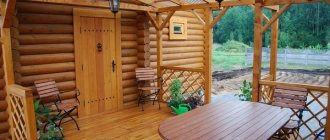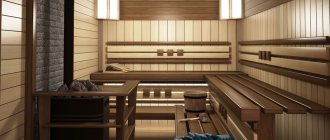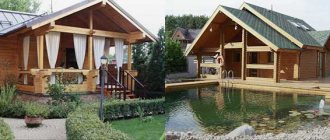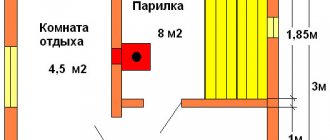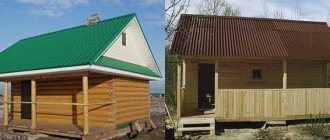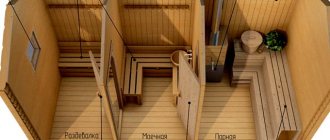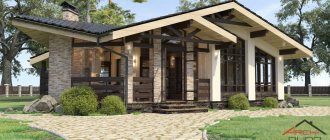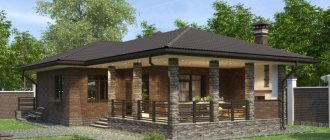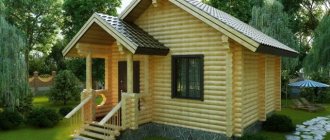New technologies and building materials from the construction industry have not been able to move the traditional log bathhouse from first place. So far it is ahead of any design in many respects.
Very often in suburban areas you can find, for example, a 6x4 log bathhouse with or without a veranda.
Log sauna with veranda
Photos of bathhouse projects with a terrace
Even at the planning stage, it is important to correctly determine the location of the future structure so that the developed technical documentation complies with the norms of current legislation.
When designing, it is necessary to take as a basis SNiP 30-02-97 and SP 11-106-97, which clearly define the rules for the development of suburban areas and indicate the recommended distance of the structure being created from other objects.
According to the standards, the minimum permissible distance of a bathhouse from other buildings, vegetation to:
- main residential building - from 7 to 10 m;
- roadway - from 6 to 7 m;
- borders of the estate, fence - from 1 to 3 m;
- neighbors’ houses – from 15 to 17 m;
- wooden utility blocks - from 10 to 13 m;
- structures made of non-combustible materials - from 6 to 9 m;
- well – 10 m;
- forests – 16 m;
- trees – 4 m;
- bushes - 2 m.
If the terrain allows, then the craftsmen recommend building a bathhouse on a hill to simplify the drainage of water from the steam room, shower and improve ventilation. In this case, screw piles will be the best foundation.
Let's take a closer look at the features and advantages of different designs with a terrace with examples of finished objects in the photo.
Baths with attic
To rationally use the under-roof space of the bathhouse, take a closer look at the projects of buildings with an attic, which will contain either a living room or a guest bedroom. In the photo you see exactly this version of a bathhouse, built from logs in a modern country style - here the urban spirit can be seen in the continuous glazing of the attic floor.
By combining a bathhouse with a gazebo under one roof, you get two recreation areas at once - one indoors and the other outdoors, and in order to get some air after the bathhouse, you don’t have to go to the other end of your site. With this layout, you will have another convenient space for a meal or intimate conversation in close proximity to the steam room.
See also: Beautiful roofs of private houses: photos, design options, views
Under the same roof
It is considered a universal option. Most often, summer residents build this way due to the ease of construction and economical consumption of materials.
Photo: bathhouse made of foam blocks and a summer terrace with barbecue under one roof
When the terrace is under a common roof with a bathhouse, the rafter system rests on beams - frame elements. The option of fastening fencing is possible.
The photo below is an example of a beautiful bathhouse made of fresh logs, complemented by a summer extension for relaxation.
Here is a version of a timber bathhouse with a small terrace. Floor finishing - decking. The roof is pitched. The design looks simple and at the same time modern.
The terrace can be located along the facade (front), next to one of the walls (side), along three walls or around the entire building (encircling), along adjacent walls (corner).
With grill or barbecue
The recommended area of the attached room, taking into account the installation of a barbecue, is from 7 square meters. m or more. For a large company, an area of 10 square meters is considered optimal. m. If in the first case it will be possible to place only a table with chairs, then in the second it will be possible to add several wicker chairs. Vacationers will not be disturbed by smoke from the barbecue. The person doing the cooking will not be constrained in his movements.
It is important to take into account that the foundation for the barbecue installation is laid separately. The average height is 70 cm from the floor.
The main material for the construction of the furnace is red fireclay brick, which has increased resistance to high temperatures.
To eliminate the risk of fire from a barbecue, the area around is laid with fireproof ceramic paving slabs.
The stove itself is lined with artificial or natural stone.
It is necessary to choose the right location and install a chimney, which is responsible for removing burning and smoke from the room. The comfort of not only vacationers, but also neighbors depends on the quality of work.
You can also provide space for a niche that will serve as a woodshed.
With a well-designed plan, such a terrace will take on the functions of a summer kitchen.
Glazed
Glazing of the veranda is made of plastic, aluminum, and wooden sliding frames.
Plastic frames are an essential element of warm glazing. Used in closed extensions for year-round use. Provide good heat and noise insulation.
Aluminum and wooden frames with glass are placed in unheated extensions, since they do not retain heat well and the indoor temperature in cold weather differs from the outdoor temperature by only a couple of degrees.
Photo: log house with terrace and bathhouse
The veranda with panoramic glazing looks great. Vacationers have an overview of the site. Being indoors, a person becomes closer to nature.
The downside is that everything that happens in the extension is also clearly visible.
Another option for glass structures is sliding walls. The closed veranda quickly transforms into an open one. The frame is made of plastic.
The windows can be decorated with multi-colored stained glass windows, thanks to which the lighting in the room will shimmer in different colors.
Two-story
A two-story structure is suitable for owners of a small plot, with no space for the construction of additional extensions.
In the classic version, the steam room, shower room, dressing room are located on the first floor, the guest or relaxation room is on the second.
Photo of a wooden bathhouse made of rounded logs with a small terrace and balcony.
The second floor turns out to be an attic and is located under a sloping (gable) roof. Due to this form, the free space can be fully utilized.
We must not forget the regularity - the larger the area of the structure, the longer it will take to warm up.
The main requirement for buildings with several floors is the presence of reinforced floors that will support not only the weight of a person, but also furniture.
The two-story bathhouse with a covered terrace can comfortably accommodate many guests. If space allows, then one rest room should be made downstairs, the second upstairs.
One-story
Photo: Russian-style bathhouse
Usually this is a small house with a covered summer extension for relaxation. The internal set of rooms is standard - locker room, washing room, steam room. Construction of a one-story bathhouse is inexpensive.
But there are also one-story bathhouses of increased comfort, which have a swimming pool, a relaxation room, several bathrooms, and a kitchen. Such a project costs many times more.
The terrace for such a building is a remote seating area for warm weather. If we are talking about a glassed room, then you can use it all year round.
Closed
Can be used regardless of the season or outside temperature. It is customary to glass it with metal-plastic double-glazed windows, which perfectly retain heat in the room. The roof can also be made transparent if desired.
A stove and a fireplace for heating are installed inside, and a niche is set up for a woodshed. An alternative is gas or electric heating.
Flowers in pots are placed on the walls and window sills. Skillful housewives turn such a terrace into a full-fledged greenhouse.
The construction requires high-quality insulation of both the foundation, walls, and roof.
If the area is large, then you can make a gym or home library on the terrace.
Open
It is considered a summer recreation area. It is not customary to glaze it. Instead of walls and windows, railings up to 1 m high are installed around the perimeter. Depending on the project, you can do without them altogether.
This covered canopy is good protection from rain and sun.
The floor is made slightly sloping for better water drainage. Material – terrace board, stone, tile.
Photo: you can make a garden house or a small bathhouse from a construction trailer
The following are placed in the open area:
- table with chairs;
- shops;
- sun loungers;
- wicker rocking chairs;
- barbecue and woodshed for it;
- small cutting table.
The number and types of interior items are selected according to the area of the structure.
With a balcony
A balcony can be added to two-story baths. But such construction will take a lot of time and money. The average area of such a structure with a balcony is from 30 to 45 sq.m. In bath complexes the figure is significantly higher.
At the project development stage, several sketches of the future balcony are created separately, a view from the outside and inside, the material consumption is calculated, and a decision is made whether to cover it with double-glazed windows or leave it open.
The roof for such a bathhouse is made so that it completely covers the balcony.
Roofing at an angle - reducing free space. But nevertheless, there will be enough space on the second floor to install a billiard table, a large corner sofa with armchairs and a table.
The space leading up will also be taken up. The design of the steep spiral staircase is interesting. Classic - carved wood.
With a rest room
With it, the bathhouse turns into a guest house. In the recreation room, a wood-burning or electric fireplace is installed, a plasma TV is hung on the wall, and chairs and a sofa are placed. Avid athletes equip the room with exercise equipment.
Photo of a wooden bathhouse project with a relaxation room on the second floor.
Let's assume the option of an open veranda. When, after a steam room in warm weather, guests are placed in the fresh air.
Bath complexes have several rest rooms.
If you don’t have the money to build such a structure, you can easily rent it for a few days.
After all, constant maintenance and heating of such a building is expensive. It is not surprising that many owners take up construction not for personal recreation, but to make a profit from rentals.
Pros of having a relaxation room in the bathhouse:
- year-round operation;
- your rest will not be disturbed by annoying insects;
- possibility of installing various household appliances;
- reception and accommodation of guests.
There are projects where the room is equipped with a minibar, a billiard table, armchairs and a poker table.
We recommend reading our other articles:
- Do-it-yourself bathhouse shelf made of wood
- How to make a bath floor correctly
Baths with swimming pool
The photo shows the original layout of the bathhouse, consisting of three spaces: the main building with a steam room, a pool area under a glass roof and a gazebo. All parts of the building are built of logs, and the roof acts as a unifying element, giving the bathhouse architectural integrity.
A spacious wooden bathhouse with a gazebo under one roof will become even more comfortable for relaxation if there is a swimming pool adjacent to the building. And to make the transition from the bathhouse to the pool easier, the floor in the gazebo and the decking around the pool are laid on the same level, for example, with a terrace board.
Drawings and diagrams of a bathhouse with a terrace
Photo: diagram of a two-story wooden bathhouse 6x6 meters.
Following the step-by-step instructions, the first step is to draw up a drawing of the future structure. As a basis, you can take existing buildings with completed calculations, a ready-made estimate, or develop a project yourself.
A visual image of the building simplifies and speeds up installation work, and allows you to document and eliminate possible shortcomings.
For a small family of 2-3 people, a one-story bathhouse with a closed terrace is quite enough. If the number of residents reaches 5–8 people, then it is better to consider the design of a medium-sized bathhouse with an attic.
Downstairs, according to the standard, there is a steam room, a shower room, a dressing room, a relaxation room and a kitchen (if the area allows). The second floor is equipped for comfortable leisure of the whole family. A billiard table is installed here, a games room or home cinema is set up.
The diagram above is an example of a one-story bathhouse with a terrace and a swimming pool inside.
Photo. Bathhouse 2.3x6 meters made of profiled timber 100x150x6000 mm with an open terrace 2.3x1 m under a common roof.
This drawing is suitable for a country holiday with a small family. An open extension is made under one roof.
Scheme of a one-story bathhouse 6x6 meters
This is an example of a one-story bathhouse with an open terrace and a large relaxation room.
Bathhouse layout with a garage for 2 cars, a veranda and a utility room.
An interesting design option, where the bathhouse is combined with a garage on one side, and on the other side there is a terrace, and there is also a utility room.
How to build a sauna from logs
Below instructions will tell you the main stages of construction. Try to stick to them.
How to prepare material for work
- Plane the log “under the bracket.” The difference between the upper and lower diameters by more than 30 mm is unacceptable.
- Saw along the length of the wall and arrange into sets. Place logs with unequal lower and upper diameters in a corner with different ends and cut them at right angles.
- Cut out the grooves and “paws”:
- In the “bowl” is the most common method. There are three options, in one of which the “bowl” is turned down, allowing you to protect the wood from possible rotting;
Cutting into a bowl
- In the “paw” - the most economical option. However, subsequently such compounds begin to rot, so the first option is preferable.
Cutting into the paw
- After cutting down all the “paws”, check how tightly the logs fit. If not enough, put it on the bottom tow.
Layout of a 6x4 bathhouse with a veranda, a relaxation room and an entrance hall
Foundation
The construction of a bathhouse with your own hands should begin with the foundation, having first determined the nature of the soil on the site. Most often, a log bathhouse is installed on a columnar foundation, the depth of which is 700-1000 mm. They use brick, concrete or stone for this, as they are more durable than wooden pillars.
The strip base should be erected when it:
- garden;
- forest;
- clayey;
- loamy;
- marshy;
- from coarse sand or fine gravel.
When the building is located on a slope, or when swelling of the soil is possible, a screw or pile foundation for the bathhouse should be made.
Project of a 6 by 6 bathhouse with a veranda on a summer cottage
Walls
- Waterproof the foundation with two layers of roofing felt.
- Install the “mortgage crown”.
- Place the first pair of logs on the foundation parallel to each other on opposite sides.
- Cut them into a “bowl” for laying the top logs.
- Place the next pair of logs into the finished slots. Check the connection, it should be at right angles.
- Install the second crown and all the others in the same way.
How to caulk walls
The process involves filling the cracks between the wooden elements of the bathhouse, for example, logs and in the notches, with fibrous materials. In this case, the material for caulking should protrude from the grooves on both sides of the frame by 50 mm or more.
Spread the fiber materials so that their fibers are located across the groove. After this, they are hammered into the cracks using caulking. Work should be carried out consistently around the entire perimeter of the bathhouse. The inside needs to be caulked after the outer layer.
Tip: to reduce the ventilation of the walls, apply caulking twice - after erecting the walls and after they have settled.
Roof structure
When building a 6 by 3 bathhouse with a veranda, use a pitched or gable roof. Make rafters from well-dried coniferous wood. Remember the main thing: when installing the roof and conducting communications, you should not drive nails directly into the logs; the bathhouse will shrink over time.
Veranda
The sauna terrace is a great place to take a break from the steam room in the summer. It can be attached to an already finished structure or done simultaneously with it. The second option is more practical, since in the first case you will have to wait 1.5-2 years until the wood dries and shrinks.
It differs from an ordinary room in that it has no walls. But, they can be made sliding, turning the veranda into an additional room. (see also the article Projects for bathhouses made of rounded logs: options)
Selection of materials for building a bathhouse
Let's look at the types of raw materials that are in greatest demand.
Tree
Traditional material for Russian baths. Retains heat well and is environmentally friendly. Certain breeds have a healing effect on the body.
But wood requires additional protection from moisture, insects, and fire, so before construction it is treated with special means.
For a small bathhouse with a terrace, a columnar foundation or, on difficult soils, a pile foundation is sufficient.
In order for the tree to last longer, it is necessary to make high-quality waterproofing between the wooden covering and the foundation.
The following types of wood are used for construction.
Log
Whole, sanded trunks are taken, which do not need to be rounded. The construction of a bathhouse from a fresh log house is done by grooving the parts together.
The logs are placed perpendicular to each other. Gutters are formed in them, along the edges there are recesses of the same size.
If you order calibrated logs of the same diameter, the corners of the building will look neater.
The wood is impregnated with antiseptics and fire retardants (the latter are needed for protection against fire).
Beam (profiled, glued)
Logs are cheaper, which is why they are more popular.
There is a particularly high demand for profiled timber, which is usually profiled on a special machine, giving an ideal smoothness to the surface. The top of the raw material is coated with antiseptics and varnish, due to which the wood does not darken.
The outer part of the structure does not require additional finishing.
For construction, timber is cut to specified sizes. Wooden pins are used to connect the elements.
There is no need to finish the interior. But if ordinary timber was taken, then the owners prefer to cover the walls with clapboard, choosing hardwood raw materials. Coniferous species are used in rooms where there are no high temperatures (not suitable for steam rooms).
The finished design turns out neat and modern, becoming an environmentally friendly decoration of the estate.
Frame technology
This is a prefabricated bathhouse with a small canopy. It won't cost much. It will fit even on a site with limited space. Differs in installation speed. A popular material is timber.
If the structure is well insulated, it can be used in winter.
Block and brick
They are used for the construction of baths that will be used at any time of the year. Due to the significant weight of the raw materials, it is necessary to take care of pouring a reliable foundation.
Let's take a closer look at the features of the materials.
Foam block
Foam concrete has a porous structure. It is considered a breathable material. Light in weight. Large block sizes speed up laying.
Due to its poor resistance to moisture, a building made of foam concrete requires mandatory cladding both outside (along the facade) and inside.
Exterior finishing options:
- clinker tiles;
- decorative plaster;
- siding;
- block house.
The quality of thermal insulation of the foam block is inferior to wood, so it will be necessary to insulate the bathhouse from the inside.
Gas silicate block
Technical characteristics are similar to foam concrete.
But gas blocks are less resistant to moisture.
To ensure that the structure lasts longer and the material does not begin to crumble, deep penetration waterproofing is used for the walls and ceiling.
The inside of the room is plastered and finished with tiles, stone or wood.
Brickwork
This material is considered a leader in fire safety.
Due to the high cost, it is rarely used for the construction of baths.
In addition, brick construction:
- takes a long time to warm up;
- needs ventilation installation;
- laying high-quality waterproofing (brick is hygroscopic).
But, once heated, the material retains heat well. Brick walls have good sound insulation and last a long time.
The inside of the bathhouse is lined with plaster and wood. It is convenient to place a small kitchen here, install a wood stove or fireplace.
The pool can be replaced with a cold water plunge pool.
Advantages
- Natural material and environmentally friendly. Due to its natural origin, wood has a beneficial effect on the human body, giving it the opportunity to inhale beneficial substances.
- Saving money on the purchase of building materials.
- Low thermal conductivity of wood. In winter, a 6 by 6 bathhouse with a veranda retains heat well, even with thin walls. Heating costs are minimal.
- The log house of the bathhouse has an aesthetic appearance. Even log buildings of simple shapes and without additional finishing look stylish and beautiful.
- Ease of assembly is one of the most important components of a log sauna. Due to this, construction time is significantly reduced. If necessary, the building can be easily disassembled, transported and reassembled in a new location.
Bathhouse with veranda 6 by 4 made of logs
Selection of materials for decking flooring
Basic recommendations for flooring in an open extension:
- Wear resistance. The material should not wear off even over the years.
- Not slippery, even when wet. This will reduce the risk of injury when walking on it.
- Low temperature resistance. Refers to regions with severe frosty winters.
- Do not deform under the influence of moisture or precipitation.
There are no such restrictions for a closed terrace, since the floor is not exposed to external factors.
Let's look at popular flooring materials.
Tiles, porcelain stoneware
The tiles are taken with the most rough, textured surface to prevent slipping.
Suitable tiles:
- ceramic;
- sidewalk;
- concrete.
It is strictly not recommended to use tiles. When wet, it becomes very slippery, which leads to unwanted injuries.
It is possible to lay porcelain tiles and pieces of stone. This flooring will go well with a bathhouse made of blocks and bricks.
Terrace board
Terrace boards are made from natural solid wood or with the addition of polymer raw materials. The latter type is preferable in an open terrace, since it is not afraid of moisture and does not deform due to temperature changes.
Available in the following breeds:
- oak;
- pine;
- ash;
- larch;
- hornbeam;
- teak.
It is used to cover the floor in bathhouses made of logs and beams, complementing the wooden ensemble.
Log baths
Log baths have an expressive Russian flavor, which can be emphasized even more if you cover the roof with reeds and add a small gazebo for spending time outdoors after the steam room.
An excellent addition to the exterior of a bathhouse with a multifaceted gazebo made of logs will be a fence made of carved balusters in the Russian style. A brown metal roof will add an interesting touch to the design of the building.
The log bathhouse and the extension to it in the form of a gazebo under multi-level gable roofs offset relative to each other look impressive. Such an asymmetrical pediment will give the building an unusual flavor, despite the usual rustic style of architecture.
To set off the light facades of a bathhouse made of pine logs, lay the roof with brown, red or green Ondulin - this solution will be both budget-friendly and beautiful.
If you are a lover of modern style, build a log bathhouse with a spacious terrace under a curved pitched roof. Log facades in combination with inclined supports, metal roofing and stone plinth will look very non-standard.
Features of installation of heat and vapor barrier
Insulation is carried out on closed verandas, which will be used all year round.
The walls are first checked for cracks and defects. The condition of doors and double-glazed windows is assessed in order to eliminate possible sources of cold in advance.
Builders advise performing internal insulation. This is many times more effective than external thermal insulation.
The most commonly purchased materials are sheets of polystyrene foam 10 cm thick. The downside is that the free area of the room is reduced.
Beginners may have trouble fitting the sheets due to the fragility of the foam. An alternative is rolled mineral wool, which will be simpler and more convenient to install.
There are also expensive insulation materials on sale with a foil protective coating, which are superior in thermal insulation to the previous two types.
You need to start insulating the brick walls of the terrace by installing a wooden sheathing made of bars with a cross-section of 25–40 mm. The fastener spacing is selected based on the size of the slabs. Polystyrene foam is inserted into the openings.
After insulation, the walls are finished (optional). Walls:
- putty;
- paint;
- laid out with tiles;
- covered with plastic panels.
Before insulating the ceiling, the integrity of the roof is checked. Otherwise, if the roof starts to leak, then all the work will be in vain.
The ceiling is waterproofed with perforated film. The joints are sealed with construction tape. The insulation is fixed using more reliable fasteners (screws, dowels).
Design styles of combined buildings
Below are the design styles of buildings with photographs indicating the characteristic features of each direction.
Chalet
The chalet is distinguished by the use of natural materials - wood, stone.
The building is being erected from a fresh log house. The floor of the terrace is laid out with pieces of stone. It is appropriate to place a wood-burning fireplace inside.
The furniture is selected wooden. A popular method is antique styling.
If the terrace serves as a recreation room, then installation of panoramic windows is allowed. The interior is characterized by a hunting theme. Guns and paintings with corresponding images are hung on the walls.
The color scheme is calm, without flashy tones.
Provence
The style comes from the southern coast of France. It is calm and airy.
Light-colored materials are used in the interior and decoration.
Characteristic colors:
- lavender;
- sand;
- beige;
- light pink;
- blue;
- lilac.
- soft green.
Floral patterns predominate in textiles. The terrace is furnished with many living plants in vases and pots. Embroidered bedspreads on sofas and armchairs are allowed.
In Provence, preference is given to wood among materials. They cover the walls with it and select wooden furniture.
The wood is made artificially aged, the painted boards are rubbed down or fired.
Forged parts are welcome. Paintings with landscapes are hung on the walls.
High tech
Such a building is created using the latest technologies. The terrace is equipped with a minimal set of furniture. The main requirement is functionality and practicality.
Materials:
- raw concrete;
- stone;
- glass;
- metal;
- polycarbonate
When decorating, contrasting combinations of black and steel, beige and brown are used.
The roof of the terrace can be completely glass. Panoramic glazing of the building is possible. The doors are installed sliding.
The shower room is equipped with plumbing fixtures with the latest features.
Useless interior decorations are not used in high-tech.
Oriental
A striking example of such design is the Turkish sauna. Finishing the floors and walls of the bath rooms - ceramic tiles, multi-colored mosaic pieces with plant motifs.
The main attribute of the oriental style in the bathhouse is the pool. Special attention is paid to its cladding. Entire patterns are created on the surface from pieces of stone.
When the terrace becomes a relaxation room, it is furnished with a large, comfortable, brightly upholstered sofa with pillows.
Variegated shades are also used when decorating walls. In open extensions, the walls are replaced with bright curtains.
Half-timbered
Half-timbering involves the use of frame technology for the construction of structures.
The structure is built from logs and timber. The roof is made with beams protruding outwards. Inside the room, wooden roof partitions are not hidden, but rather become a style accent.
Half-timbering implies strict lines in the interior. Part of the building is made entirely of glass for a better view of the estate.
Loft
Loft is rough lines, unpolished surfaces of materials, minimalism of details.
Imitation of unfinished brick has gained popularity in the loft. This is how the interior of the walls of the room is decorated. There is a variant of concrete walls with graffiti applied or without it at all.
In furniture, natural raw materials (wood, forging) are combined with innovations (plastic). An alternative to an upholstered chair is unpolished wooden benches.
One simple chandelier is hung in the center of the room. The use of spotlights is undesirable. A laconic combination of wood and metal is a characteristic feature of the loft.
Adding a terrace to a bathhouse means creating a space for relaxation with even greater comfort. The design option, placement, and materials are carefully thought out at the design stage, since it will not be possible to make any amendments during the construction process.
